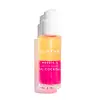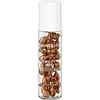What's inside
What's inside
 Key Ingredients
Key Ingredients

 Benefits
Benefits

 Concerns
Concerns

No concerns
 Ingredients Side-by-side
Ingredients Side-by-side

Water
Skin ConditioningSimmondsia Chinensis Seed Oil
EmollientCaprylic/Capric Glycerides
EmollientHydrogenated Polydecene
EmollientPersea Gratissima Oil
Skin ConditioningSqualane
EmollientGlycerin
HumectantTocopheryl Acetate
AntioxidantVaccinium Vitis-Idaea Seed Oil
AntioxidantRubus Chamaemorus Seed Oil
Skin ConditioningOxycoccus Palustris Seed Oil
AntioxidantRubus Chamaemorus Seed Extract
Skin ConditioningPhenoxyethanol
PreservativePanthenol
Skin ConditioningAscorbyl Tetraisopalmitate
AntioxidantNiacinamide
SmoothingLinoleic Acid
CleansingHydroxyethylcellulose
Emulsion StabilisingPropanediol
SolventPEG-8
HumectantOleic Acid
EmollientEthylhexylglycerin
Skin ConditioningTocopherol
AntioxidantPalmitic Acid
EmollientAdenosine
Skin ConditioningStearic Acid
CleansingAscorbyl Palmitate
AntioxidantLinolenic Acid
CleansingAscorbic Acid
AntioxidantCitric Acid
BufferingHelianthus Annuus Seed Oil
EmollientRosmarinus Officinalis Leaf Extract
AntimicrobialLimonene
PerfumingLinalool
PerfumingCitral
PerfumingParfum
MaskingCI 17200
Cosmetic ColorantCI 19140
Cosmetic ColorantWater, Simmondsia Chinensis Seed Oil, Caprylic/Capric Glycerides, Hydrogenated Polydecene, Persea Gratissima Oil, Squalane, Glycerin, Tocopheryl Acetate, Vaccinium Vitis-Idaea Seed Oil, Rubus Chamaemorus Seed Oil, Oxycoccus Palustris Seed Oil, Rubus Chamaemorus Seed Extract, Phenoxyethanol, Panthenol, Ascorbyl Tetraisopalmitate, Niacinamide, Linoleic Acid, Hydroxyethylcellulose, Propanediol, PEG-8, Oleic Acid, Ethylhexylglycerin, Tocopherol, Palmitic Acid, Adenosine, Stearic Acid, Ascorbyl Palmitate, Linolenic Acid, Ascorbic Acid, Citric Acid, Helianthus Annuus Seed Oil, Rosmarinus Officinalis Leaf Extract, Limonene, Linalool, Citral, Parfum, CI 17200, CI 19140
 Reviews
Reviews

Ingredients Explained
These ingredients are found in both products.
Ingredients higher up in an ingredient list are typically present in a larger amount.
Ascorbic Acid is is pure Vitamin C. This form makes up the largest amount of vitamin C found naturally in our skin.
Not only is vitamin C great for your overall health and immune system, it also has plenty of benefits on your skin.
Vitamin C is best used for brightening skin. It improves dark spots, acne scars, and hyperpigmentation. This is because it blocks the process of skin darkening when exposed to UV.
Remember: Vitamin C should not replace sunscreen!
Your skin uses vitamin C to build collagen. Collagen is one key component in having a strong skin barrier and plump skin. Vitamin C also plays a role in regulating collagen, thus making it effective in improving wrinkles and fine lines.
Ascorbic acid shows potent antioxidant activity. As an antioxidant, it helps fight free-radicals. Free-radicals are molecules that may damage your skin cells. These antioxidants also protect skin against UV damage.
The best formulations include Vitamin E and/or ferulic acid. These two ingredients help stabilize and provide a boost in the benefits of ascorbic acid. This is because ascorbic acid becomes unstable when exposed to UV and air. In fact, you can tell your ascorbic acid has oxidized when it turns an orange-yellow color.
Ascorbic acid is generally compatible with other ingredients. However, using ascorbic acid with other active ingredients might cause irritation. Two ingredients: copper ions and benzoyl peroxide, will inactivate ascorbic acid completely.
Read more about other types of Vitamin C:
Foods rich with vitamin C include oranges, strawberries, broccoli, bell peppers, and more. When consuming Vitamin C, your skin receives a portion of the nutrients.
Learn more about Ascorbic AcidTocopheryl Acetate is AKA Vitamin E. It is an antioxidant and protects your skin from free radicals. Free radicals damage the skin by breaking down collagen.
One study found using Tocopheryl Acetate with Vitamin C decreased the number of sunburned cells.
Tocopheryl Acetate is commonly found in both skincare and dietary supplements.
Learn more about Tocopheryl Acetate